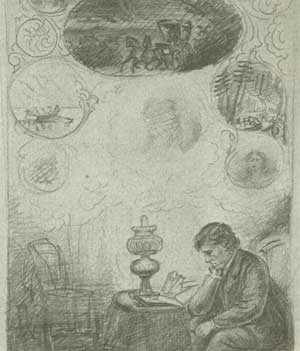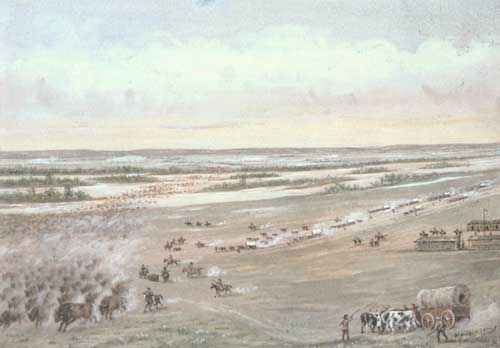
INTRODUCTION
By Marian Albright Schenk
FOREWORD
By Dean Knudsen
SECTION 1
Primary Themes of Jackson's Art
SECTION 2
Paintings of the Oregon Trail
SECTION 3
Historic Scenes From the West
 |
| In this 1865 double exposure, Jackson makes it appear he and a friend are being visited by a ghost. In reality, it was the shame of a lover's spat that haunted Jackson for the rest of his life. When Jackson died in 1942, a portrait of his first love, Caddie Eastman, was found among his personal effects. The ambrotype is now in the possession of the Brigham Young University Library. (SCBL 3049) |

Section 2: Paintings of the Oregon Trail
LEAVING CIVILIZATION BEHIND
When William Henry Jackson's wagon train departed Fort Kearny in June of 1866 he was literally leaving civilization behind. And that is exactly what he had in mind when he decided to follow Horace Greeley's advice to "Go west, young man." Jackson's stated goal in going west was to make his fortune in the goldfields of Montana—but in reality, he was a fugitive.
Jackson was not running away from creditors or the law, but rather, he was seeking escape from an affair of the heart. When he left the army in 1863 and returned to civilian life, the young Jackson immediately got a job as an artist in a photographic gallery in Burlington, Vermont. Soon he was making good money, spending it extravagantly, enjoying himself in an exclusive social circle—and he was very much in love.
The object of Jackson's affections was a young lady named Caroline "Caddie" Eastman. The product of a prominent Vermont family, she and Jackson reached an "understanding" in 1864, and were engaged to be married. As so often happens with young sweethearts, they had a minor argument. Things were said that neither really meant, but feelings were hurt and their wedding was called off. Jackson wrote:
 |
| Remembrances 1866. Although Jackson claimed to have forgotten what sparked the argument that resulted in the termination of his engagement to Caddie Eastman, this is almost certainly a subterfuge, as Jackson's memory of events both before and after the incident was crystal clear for the remaining sixty-six years of his life. (SCBL 115) |
She had spirit. I was bull-headed, and the quarrel grew. I was, so to speak, discharged and since I found it impossible in my shame to face the world, I renounced it. . . There was only one course open to me; I must leave Vermont forever.1
Too embarrassed to face his family and friends, Jackson packed a few belongings and left town for the anonymity of New York City. There he happened to meet a Civil War comrade who was also at loose ends, and together they decided to seek their fortunes in the West. With very little money, the young vagabonds eventually made their way to the frontier, and that is how they came to find themselves setting out onto the seemingly endless plains of Nebraska.
If Jackson really went West in order to "forget," he did a rather poor job of it. In his autobiography he remarks that throughout his western travels he always made sure to leave a forwarding address, obviously in the hope that Miss Eastman might relent and ask him to return home. However, no such letter ever arrived and the heartbroken Jackson continued his wanderings on the High Plains.
An artifact of this affair survives in the form of a pencil sketch entitled "Remembrances 1866." The drawing depicts a melancholy young man reflecting on a lost love. This portrait of a disappointed lover in the depths of despair is obviously a reflection of Jackson's own tortured emotions.
1. Jackson, Time Exposure, 82-83.
 |
| West of Fort Kearny. Unsigned and undated. 25.4 x 35.5 cm. (SCBL 22) |
 |
scbl/knudsen/sec2e.htm Last Updated: 14-Apr-2006 |
 |